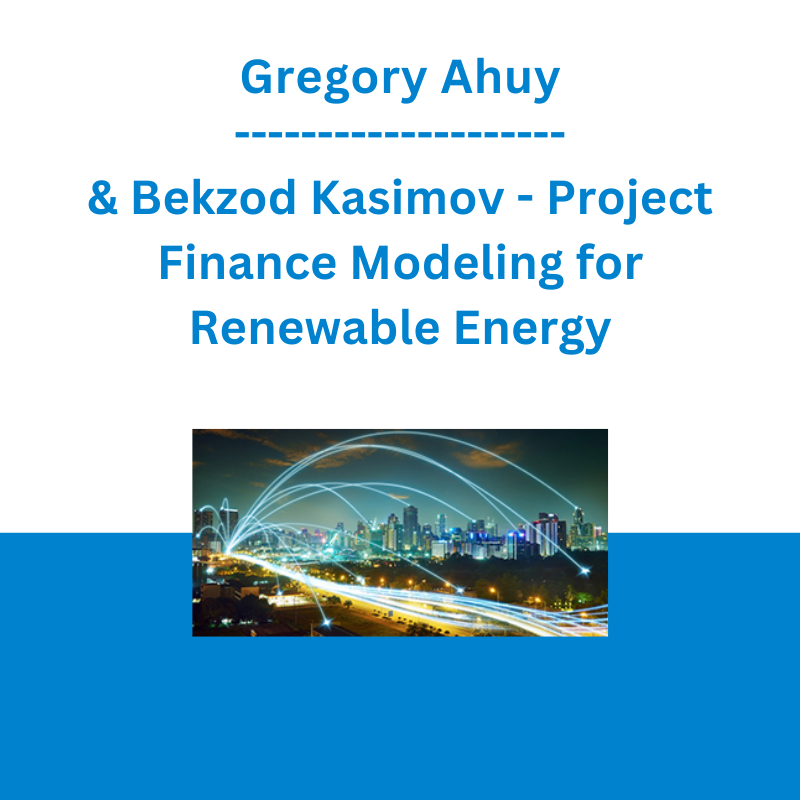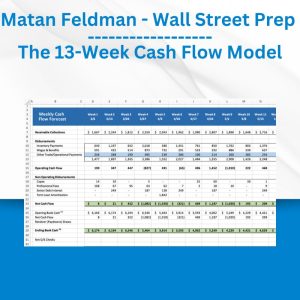*** Proof of Product ***
Exploring the Essential Features of “Gregory Ahuy & Bekzod Kasimov – Project Finance Modeling for Renewable Energy – Financial Model Online”
Create Financial Models for Wind and Solar
Project Finance Modeling for Renewable Energy course will give you the skills to develop and analyze project finance models for wind and solar projects.
Project Finance Modeling Course Objective
Project Finance Modeling for Renewable Energy course will give you the skills to develop and analyze project finance models for wind and solar projects. The course covers essential topics including debt sizing and funding, wind and solar project operations, and investment returns, and will provide you with a robust financial modeling skillset for analysis of renewable projects in the most sophisticated environments.
In an online environment, you will go from a blank Excel workbook to a financial model suitable for investment analysis, debt structuring, and operational scenario evaluation. This course will provide step-by-step instructions on how to build a financial model suitable for analyzing wind and solar projects.
By the end of this course, you will be able to build complex, real-life project finance models for wind and solar projects.
What This Course is About?
Project finance models for renewable energy are used to assess the risk-reward of lending to and investing in renewable projects (wind and solar). The project’s debt capacity, investment returns, and financial feasibility depend on expected future cash flows generated by the renewable energy project itself and a financial model is built to analyze this.
In the Project Finance Modeling for Renewable Energy course, we will model complex wind and solar project finance transactions from scratch in excel.
You will learn about:
- How to build a project finance model from scratch in excel for wind and solar projects;
- How to create best practice macro’s and Excel VBA codes to break circularities;
- How to size debt based on multiple covenants for wind and solar projects;
- How to model Debt Service Reserve Account;
- How to integrate multiple probability exceedance generation profiles (P50, P99) into the financial model;
- How to model unlevered project returns and blended equity return;
- You will learn basics of GP/LP flip structures and tax equity for project financing;
- Optimize the model to achieve the requirements of lenders and investors;
This is the same comprehensive financial training used to prepare analysts and managers at top financial institutions and infrastructure funds.
How Does It Work?
The course length is over 15 hours.
First, we will review the basics of wind and solar projects development, so we understand all essential components of project finance transactions in the context of renewable energy.
Then, in the second part, we will review financial modeling methods and excel functions that we will use often in this course, to improve our productivity in excel.
We will begin financial modeling in the third part, where we will build a financial model for wind and solar projects for the case when SPV pays taxes.
And, finally, In the fourth part, we will review the peculiarities of the US renewable projects and build a financial model that takes into account the tax credits available in the US, and introduce a new source of financing called tax equity.
Is This Course For You?
Yes, if you need to build, review or analyse project finance models for wind and solar projects.
Typical students include analysts, managers, senior managers, associate directors, financial advisors, financiers and CFOs from project companies, investment banks, private equity and infrastructure funds.
Course Prerequisites
You will need previous exposure to Excel in a financial modeling context and basic knowledge of investment concepts such as NPV and cash flows.
Meet Our Instructors
Greg Ahuy
Founder / Financial Modeler
Greg started his career in investment banking as M&A analyst in London at Renaissance Capital – leading investment banking firm in Emerging Markets with offices in London, New York, Hong Kong and Johannesburg. He was responsible for some of the biggest M&A deals in mining and infrastructure sectors in emerging and frontier markets. Gregory continued his career at InfraRed Capital Partners, one of the largest infrastructure funds, focused on sourcing and executing greenfield and brownfield infrastructure projects in Eastern Europe. Later, Mr. Ahuy joined Eneco, one of the largest energy companies in the Netherlands where he led several renewable energy projects.
Bekzod Kasimov
Financial Modeler
Bekzod started his career at ABN Amro Bank as a financial analyst and was responsible for credit and risk analysis of syndicated loans. After that, he joined the merchant banking firm ECM as an investment analyst and was responsible for the origination and execution of investment opportunities in the infrastructure, oil & gas and mining industries. He continued his career at Vancouver-based mining and infrastructure company as a vice-president business development and was responsible for project acquisition and development in the US, South America and Asia. Bekzod was involved in a number of mining, power and renewable energy projects acquisitions in the US, Asia and South America.
Check Out Detailed Course Curriculum
Introduction to the Course
Intro to the Course(2:23)
Part 1 – Basics of Wind and Solar Projects Development
Renewable Energy Overview(2:43)
Wind and Solar Equipment(3:02)
Energy Generation(5:23)
Wind and Solar Resources(16:01)
P-Value, Probability and Excel(8:22)
Quiz 1 – Equipment, Energy Generation and Resources
Selling Energy under the PPA(7:20)
Risk Allocation under the PPA(3:50)
PPA terms(4:48)
Quiz 2 – PPA terms
Construction Contracts in Renewable Energy Development(5:17)
Construction Risks(6:02)
Operating Costs(4:02)
Quiz 3 – Renewables Construction and Operation
Financing of Renewable Energy Project(4:28)
Role of the SPV in Financing(3:50)
Sources of Financing for Renewable Energy Projects(5:45)
Loan Agreement(5:49)
Debt Sizing(5:01)
Debt Sizing Example(9:59)
Control Accounts & Cash Flow Waterfall(5:32)
Covenants in Project Finance(4:16)
Quiz 4 – Financing
Part 2 – Excel Refresher
Calculations in Blocks(10:23)
Paste Forward Link(4:30)
Daisy Chains and Link Formatting(3:55)
Using Placeholders(2:13)
Most Used Excel Shortcut Keys(7:52)
Understanding Anchoring(3:52)
Understanding Dates(5:25)
Understanding IF Statements(4:52)
Understanding SUMIF function(6:04)
Understanding LOOKUP function(5:37)
Understanding MIN MAX functions(2:38)
Part 3 – Financial Modeling For Wind and Solar Projects (SPV pays taxes)
Introduction to the Financial Model and Case Study(5:10)
Timing and Flags(4:35)
Modeling Dates(10:50)
Modeling Flags 1(8:29)
Modeling Flags 2(8:31)
Modeling Flags 3(15:53)
Modeling Energy Generation
Energy Generation Recap(1:28)
Modeling Energy Generation(13:36)
Modeling Energy Generation with Seasonality Factor(8:40)
Selling Energy
Selling Energy Recap(1:25)
Modelling Revenue(15:44)
Operating Costs
Operating Costs Recap(0:47)
Modeling Operating Costs(11:54)
Working Capital
Understanding Working Capital(4:49)
Modeling Working Capital(12:07)
PP&E and Depreciation
Understanding PP&E and Depreciation(3:38)
Modeling PP& and Depreciation(11:34)
Tax Expense and Tax Paid
Understanding Taxes(6:23)
Net Operating Losses(4:39)
Modeling Taxes 1(9:55)
Modeling Taxes 2(17:05)
Equity, Dividends and Cash
Understanding Equity(4:34)
Modeling Equity, Dividends and Cash – 1(11:50)
Modeling Equity, Dividends and Cash – 2(14:18)
Sizing the Debt for Wind and Solar Projects
Debt Sizing for Renewable Projects(2:23)
Sizing the Debt -1(21:29)
Sizing the Debt – 2(14:57)
Modeling Construction Phase
Construction Timing(4:11)
Modeling Construction Costs(11:39)
Understanding Construction Funding(4:12)
Construction Funding Overview(7:28)
Modeling Construction Funding 1(13:00)
Modeling Construction Funding 2(15:34)
Financing costs 1(15:03)
Financing costs 2(21:23)
Linking Funding Sheet to Operations 1(12:25)
Linking Funding Sheet to Operations 2(13:43)
Term Loan
Modeling Term Loan(11:29)
Project Finance Debt Ratios
Understanding DSCR(6:23)
Modeling DSCR(8:07)
Understanding LLCR & PLCR(5:30)
Modeling LLCR(12:56)
Modeling LLCR based on effective interest rate(14:31)
Debt Service Reserve Account (“DSRA”)
Understanding DRSA – 1(2:24)
Understanding DSRA – 2(5:24)
Modeling DSRA 1(18:00)
Modeling DSRA 2(8:51)
Modeling DSRA 3(9:42)
Modeling DSRA 4(12:20)
Shareholder Loan
Understanding Shareholder Loan – 1(3:06)
Understanding Shareholder Loan – 2(4:23)
Modeling Shareholder Loan – 1(6:24)
Modeling Shareholder Loan – 2(14:27)
Modeling Shareholder Loan – 3(6:36)
Project Returns
Project Returns Overview(3:51)
Modeling Project Returns – 1(11:17)
Modeling Project Returns – 2(12:54)
Project Optimization(19:45)
Model Checks and Scenario Manager
Modeling Checks(22:17)
Modeling Scenario Manager(9:30)
Construction Funding Macro(6:52)
Summary Sheet
Summary(3:17)
Course Review
Part – 4 Financial Modeling For Wind and Solar in US
Investment Structuring(2:56)
Tax Efficiency(7:51)
Modeling PTC(5:49)
Modeling ITC(8:57)
Modeling Tax Benefits for Efficient Taxpayer(3:27)
Modeling Tax Benefits for Inefficient Taxpayer(11:44)
NPV of Tax Benefits(4:48)
Modeling Returns of the Efficient and Inefficient Taxpayer(11:04)
Understanding Tax Equity – 1(4:20)
Understanding Tax Equity – 2(4:46)
Intro into Tax Equity Modeling(3:57)
Tax Equity Modeling 1 – Sizing Tax Equity(9:14)
Tax Equity Modeling 2 – Sizing Back Leverage Debt(11:17)
Tax Equity Modeling 3 – Construction Funding(14:37)
Tax Equity Modeling 4 – Sponsor’s Tax Credits and EBT(11:06)
Tax Equity Modeling 5 – Sponsor’s Tax Liability(9:42)
Tax Equity Modeling 6 – Sponsor IRR(7:48)
Tax Equity Modeling 7 – Summary(17:37)
Part 5 – Final Task
Final Task(6:49)
Course Review
Please see the full list of alternative group-buy courses available here: https://lunacourse.com/shop/









